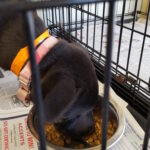So fellow travelers, one small downside to the extended trips we take to the Left Coast each summer is I miss all the action for a couple of weeks at the local dog rescue where I volunteer.

‘Cuse me, are my people here yet?
Going into my sixth year of volunteering (I started seven years ago back in November 2010, but took a year off to attend to important family responsibilities) it does not take long to get back into the swing of things no matter how long I am gone. So bright and early this Saturday, I headed off to help welcome sixty new furry arrivals seeking homes. When I pulled into the parking lot just after 7:30am the big truck was already in position, ramp down ready for the our transport team to get the dogs out and settled in.
 Thanks to the dedication of a hardworking staff and a solid core of trained volunteers, Helping Hounds Dog Rescue has become a well organized operation. Transport shifts are hectic. Cooperation and flexibility are essential. There’s a lot to get done before doors open to the crowd of potential adopters who line up well before Noon.
Thanks to the dedication of a hardworking staff and a solid core of trained volunteers, Helping Hounds Dog Rescue has become a well organized operation. Transport shifts are hectic. Cooperation and flexibility are essential. There’s a lot to get done before doors open to the crowd of potential adopters who line up well before Noon.
Adopters waiting for doors to open.
Before the transport dogs are brought in, all the dogs currently on site have to be fed and walked, crates cleaned, water replenished and laundry started. Thanks to the “Morning Marauders” weekend team this happens with good humored, coffee and donut fueled efficiency so by the time the Transport Team shifts into gear the new dogs will have the full attention of everyone on hand.
By the time the dogs arrive here, they’ve been through a lot. Whatever the circumstances (strays, puppy mill raids or owner surrenders) which find them in held in high kill shelters, its a terrifying experience for any animal. The lucky ones are “pulled” by rescue organizations in Texas and Alabama, given vet care including spay/neuter and sent to foster homes to wait for an available opening on the transports headed to other states. When a slot opens up, the dogs are loaded onto the transports often traveling several days (yes they are fed and walked and cared for along the way) to reach their new home state. So by the time we meet them coming off the truck, they are understandably a bit stressed and disoriented.
Some of them bound down the ramp, thrilled to explore this funny smelling new place. Others have to be coaxed or carried to the stations where they have their arrival photos taken and are fitted for collars with official HHDR tags. It’s not uncommon for us to end the shift a bit damp but we all agree it’s worth wearing a little eau de pee in exchange for a gentle lick on your ear as you comfort a trembling little chi-mix or shy puppy. A good breakfast, a few walks and extra buddy time for any dog in need of comfort does wonders to soothe nerves and settle fears. Most are ready to meet potential adopters by the time the doors open and people start streaming in.

Pups resting before the doors open to the public
At that point I usually switch roles to answering the phones, freeing up the staff to focus on processing adoptions. Other volunteers act as tour guides showing people around and answering questions, bringing dogs out to meet interested adopters or at any moment assisting when a call goes out for a “crate cleanup in the puppy room.” Staff approved volunteer team members assist with “meet and greets” a required process of introducing a family’s established dog(s) to the dog they are considering for adoption. Transport Saturdays are crazy busy, people can wait over an hour to finalize their paperwork and go home with their new companions. A few grumble, but I’ve never heard anyone say it wasn’t worth the wait once they’re walking out the door with their new companion.

One nice benefit of working the phones is I get to see a lot of the dogs go home. I always have several favorites in each new pack, dogs who touch my heart for one reason or another. My heart fills with joy as I pull their “Going Home” bags made by their foster families, then watch their new families eagerly pick extra toys or treats from our donation shelves, tucking them in with the things sent up from the families who so graciously gave them a place to rest and then let them go to make room for the next foster. To give love and let it go takes some resilience, I know, I’ve been on that side of the rescue process. Its the ability to focus on keeping space open for the next dog which makes sending them on their way ever so slightly easier. There’s no shortage of dogs needing homes so fosters know there’s will soon be a new furry guest to love.
One new addition to our transports are the Kelly Dogs, whose transports have been sponsored by a fund started in memory of Kelly Wilson, an avid HHDR volunteer who died in a tragic accident. Kelly’s enthusiasm on transport days even on the coldest, wettest of days was contagious. She and her new husband had just adopted a puppy from Texas just before she died; her family and friends wanted to help make more adoptions like that possible. Many people don’t realize there are substantial costs involved in pulling dogs out of high kill shelters and getting them to areas where the demand for adoptions is higher than the supply of available dogs (*see notation below.)
Kelly’s fund makes sure her love for these dogs lives on.

Kelly Dogs : DaVinci, Wynken, Marco, Blynken & Frida getting ready for their official photo
By the time my shift is done I’ve fully embraced the expression “dog tired” yet as tired as I am, when I leave at the end of a shift to head home and walk our own rescue girl (herself an HHDR alumni) I leave knowing I have done something to make a difference. That’s a feeling which refuels my spirit and I am grateful for the opportunity to live it.
Walk gently on the path my friends and remember kindness matters.
*HH DR works with several rescue groups in Texas and Alabama to bring dogs up here where very eager families are seeking to adopt. The process is not without concerns. There is always the question of how this impacts local dogs in need of homes. I addressed this aspect in a post from a few years back. The issue of finding a solution to the over population of certain breeds in local shelters is not a problem any community can adopt its way out of. Education of the general public and cohesive communication between rescue organizations is essential. Our area is fortunate to have groups working towards a brighter future for breeds, I for one am blessed to have in our own family. Photo : Zeus and Coffee, our daughter and son-in-law’s rescue pitbulls.
DR works with several rescue groups in Texas and Alabama to bring dogs up here where very eager families are seeking to adopt. The process is not without concerns. There is always the question of how this impacts local dogs in need of homes. I addressed this aspect in a post from a few years back. The issue of finding a solution to the over population of certain breeds in local shelters is not a problem any community can adopt its way out of. Education of the general public and cohesive communication between rescue organizations is essential. Our area is fortunate to have groups working towards a brighter future for breeds, I for one am blessed to have in our own family. Photo : Zeus and Coffee, our daughter and son-in-law’s rescue pitbulls.
Editorial Note: Sunday’s at the Rescue is a series of posts about my experiences working with rescue dogs. It is named for Sunday, a sweet young dog who came through the rescue where I volunteer, stole a piece of my heart (as so many of them do) and got herself adopted into a great home. If you like this piece, you can search the blog for other posts with that title.
 A collection of some of my daily life in B&W photos
A collection of some of my daily life in B&W photos


 Mt Olympus from Hurricane Ridge in Olypmic Natl Park. One of the moments I missed my dslr and extra lenses.
Mt Olympus from Hurricane Ridge in Olypmic Natl Park. One of the moments I missed my dslr and extra lenses.



 Photo credit: Society for Popular Astronomy
Photo credit: Society for Popular Astronomy




 Thanks to the dedication of a hardworking staff and a solid core of trained volunteers, Helping Hounds Dog Rescue has become a well organized operation. Transport shifts are hectic. Cooperation and flexibility are essential. There’s a lot to get done before doors open to the crowd of potential adopters who line up well before Noon.
Thanks to the dedication of a hardworking staff and a solid core of trained volunteers, Helping Hounds Dog Rescue has become a well organized operation. Transport shifts are hectic. Cooperation and flexibility are essential. There’s a lot to get done before doors open to the crowd of potential adopters who line up well before Noon.







 DR works with several rescue groups in Texas and Alabama to bring dogs up here where very eager families are seeking to adopt. The process is not without concerns. There is always the question of how this impacts local dogs in need of homes. I addressed this aspect in
DR works with several rescue groups in Texas and Alabama to bring dogs up here where very eager families are seeking to adopt. The process is not without concerns. There is always the question of how this impacts local dogs in need of homes. I addressed this aspect in